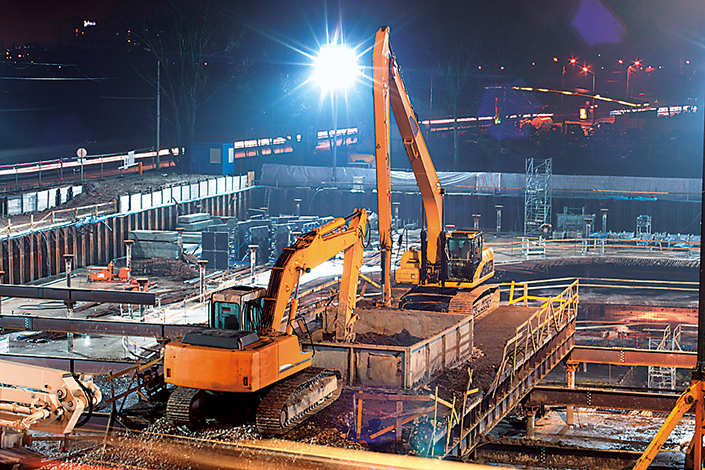How to work safely on a construction site in the dark
Contents |
[edit] Introduction
At some point within a construction worker’s career, it is likely that they will experience working in the dark.
Shift work does not necessarily need to be throughout the night in order for there to be a lack of natural light on-site. Some sites are naturally darker than others, and during the winter months, daylight hours are limited. However, for some companies, the need to meet strict deadlines will require shifts to be carried out throughout the night and for those working on a construction site to work overtime.
The practice of construction work being undertaken in the dark is relatively commonplace throughout the UK. In fact, LILUNA General President, Terence M. O’Sullivan commented, “night work has become a fact of life in highway construction.”
However, just because this practice is becoming increasingly more common, does not diminish the fundamental risks of working in the dark both associated with and independent to the construction site itself.
[edit] Why construction sites operate after dark
Working in daylight carries a range of obvious benefits; workers are generally more alert, hours are more sociable and certain risk factors are likely to be reduced. However, like night-shifts, the day-time can present with its own undesirable derivatives.
On highways and high volume roads, traffic will likely become congested as it will have to funnel through any diversions or reduced-speed areas; this is likely to cause a knock-on effect to surrounding businesses, when those travelling to work or meetings within the area arrive late.
Generally, improvements to infrastructure are designed to ease traffic congestion and generate better business for that area, therefore, working at night when there is less traffic is likely to be beneficial. The reduced traffic at night also allows for better access to the workplace. During the summer months when temperatures soar, night-shift workers benefit from cooler temperatures, allowing for longer work shifts and greater productivity.
[edit] Worker fatigue
Workers can become fatigued from a lack of light. A lack of light can impede on an employee’s vision, meaning a greater level of concentration is required in order to focus. This is especially prevalent to tasks that require attention to detail or involve an element of risk.
Working through the night can counteract the natural pattern of a person’s body clock, causing the employee to be tired, and tiredness can inhibit a person’s ability to judge a situation well. Mistakes on construction sites often bear significant financial repercussions or endanger life. It is, therefore, crucial that employees understand the importance of getting enough sleep.
Often workers feel that opting for night-shifts will give them more family time at home. However, it is essential that the same amount of hours a person would sleep in the night are slept in the day. A worker should attempt to find a place to sleep that is quiet and can block out sunlight. A routine such as this will help workers to stay alert to their surroundings and potential hazards on a night shift, minimising the likelihood of an accident occurring.
[edit] Vehicles and machinery
Most vehicles have some form of blind-spot in which the driver’s line of sight will be obscured or completely obstructed. Construction vehicles, in particular, are prone to this hindrance, as a large proportion of on-site motors carry equipment or are shaped in a manner that impedes upon visibility.
This is one of the reasons why many vehicles display warning signs such as ‘Warning, you may be in a blind spot’ and why other over-sized ones require pilot/escort vehicles, ensuring members of the public keep a safe distance.
[edit] Related articles on Designing Buildings Wiki
- Constraints on construction projects.
- Construction work in hot weather.
- General lighting v task lighting.
- Health and safety.
- Improving visibility and resilience of buried services.
- Injuries on construction sites.
- Lighting of construction sites.
- Safety.
- Safety briefing.
- Site appraisal.
- Site information.
- Site rules.
- Site safety.
Featured articles and news
RTPI leader to become new CIOB Chief Executive Officer
Dr Victoria Hills MRTPI, FICE to take over after Caroline Gumble’s departure.
Social and affordable housing, a long term plan for delivery
The “Delivering a Decade of Renewal for Social and Affordable Housing” strategy sets out future path.
A change to adoptive architecture
Effects of global weather warming on architectural detailing, material choice and human interaction.
The proposed publicly owned and backed subsidiary of Homes England, to facilitate new homes.
How big is the problem and what can we do to mitigate the effects?
Overheating guidance and tools for building designers
A number of cool guides to help with the heat.
The UK's Modern Industrial Strategy: A 10 year plan
Previous consultation criticism, current key elements and general support with some persisting reservations.
Building Safety Regulator reforms
New roles, new staff and a new fast track service pave the way for a single construction regulator.
Architectural Technologist CPDs and Communications
CIAT CPD… and how you can do it!
Cooling centres and cool spaces
Managing extreme heat in cities by directing the public to places for heat stress relief and water sources.
Winter gardens: A brief history and warm variations
Extending the season with glass in different forms and terms.
Restoring Great Yarmouth's Winter Gardens
Transforming one of the least sustainable constructions imaginable.
Construction Skills Mission Board launch sector drive
Newly formed government and industry collaboration set strategy for recruiting an additional 100,000 construction workers a year.
New Architects Code comes into effect in September 2025
ARB Architects Code of Conduct and Practice available with ongoing consultation regarding guidance.
Welsh Skills Body (Medr) launches ambitious plan
The new skills body brings together funding and regulation of tertiary education and research for the devolved nation.
Paul Gandy FCIOB announced as next CIOB President
Former Tilbury Douglas CEO takes helm.
UK Infrastructure: A 10 Year Strategy. In brief with reactions
With the National Infrastructure and Service Transformation Authority (NISTA).
























